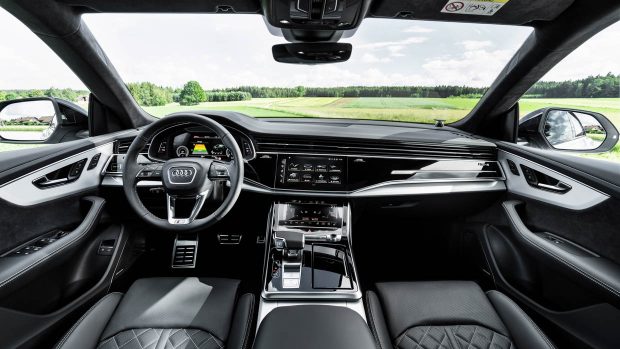-
Car Reviews
- Car News
-
Car Comparisons
Latest comparisons
- Chasing Deals
Prestige brand adds second PHEV to its Australian line-up with single-model 340kW/700Nm Q8 60 TFSIe due later this year
Mercedes-Benz may have gone cold on plug-in hybrids (PHEVs), but German prestige rival Audi is doubling down, confirming its Q8 PHEV’s arrival in the fourth quarter of this year.
Launching in a single high-specification grade, the Q8 60 TFSIe is priced from $148,375 before on-roads.
Its arrival follows that of the Q5 55 TFSIe, Audi’s plug-in hybrid midsize SUV, which launched this month.
After the brand had no PHEV in its line-up – a Q7 plug-in arrived in 2018 but was discontinued after slow sales – it now has two arriving in quick succession, boosting Audi’s electrified portfolio.
The coupe-styled Q8 plug-in enters the prestige large SUV market against sterling PHEV opposition.
Competition comes from the Volvo XC90 Recharge Ultimate PHEV ($125,990), BMW X5 50e ($149,990), Porsche Cayenne E-Hybrid Coupe ($161,600) and Range Rover Velar PHEV ($132,800).
In Audi’s own line-up, from a price perspective, the Q8 PHEV squeezes between the $135,100 petrol-powered Q8 55 TFSI and $168,800 SQ8 TFSI.
It also closely price matches Audi’s fully electric e-tron 55 large SUV with its $147,400 asking price.
While the new Q5 55 TFSI e plug-in makes do with a 2.0-litre four-cylinder turbo petrol, the Q8 PHEV brings V6 power to the party.
Its 3.0-litre turbocharged petrol offers 250kW/450Nm, and combines with a 100kW/400Nm electric motor. Together they deliver an impressive 340kW/700Nm.
Audi says this propels the 2430kg brute to 100km/h in 5.4-seconds, just 0.1-seconds slower than the smaller and lighter Q5 plug-in’s effort.
A rear-mounted 14.4kWh (usable) battery offers a claimed electric range of up to 54km on the WLTP cycle.
AC-only charging is up to 7.2kW, with a full charge happening in approximately 2.5 hours using a 7.2kW home wall box charger.
We must always take PHEV fuel consumption figures with a pinch of salt – it varies greatly depending how much the petrol engine’s used. Official figures for the Q8 PHEV are 2.6L/100km, while energy consumption (NEDC) is 21.0kWh/100km.
As Audi’s flagship Q model, all Q8s are generously appointed, including this new PHEV.
Standard is Audi’s S-line exterior styling, 21-inch alloys exclusive to the model, red brake callipers, panoramic sunroof and HD Matrix LED headlights.
The cabin features Valcona leather upholstery, heated front sports seats, heated steering wheel, tri-zone climate control, three screens for the dash and driver display, ambient lighting, head-up display, wireless Apple CarPlay/Android Auto and a Bang & Olufsen 3D sound system.
Driver assistance includes adaptive cruise control with traffic jam assist, 360-degree camera, park assist and intersection assist.
Audi Australia told Chasing Cars last year its Q7 PHEV was not under consideration for local re-introduction as it was compromised with just five rather than the usual seven seats.
The Q7 e-tron PHEV first arrived here in 2018 after numerous delays, pairing a V6 turbodiesel with an electric motor. It offered a 56km battery-only range.
Its $139,000 price was a significant $33,000 leap over a normal Q7 diesel. That and the lack of third-row seating meant sales were slow.
Prior to this, in 2015 Audi introduced an A3 e-tron PHEV. It was also hampered by a high purchase price: at $62,490 it was around $25,000 more than a combustion A3 equivalent. An electric-only driving range of 30km was another sticking point.
The right-hand-drive UK market has offered the Q8 plug-in for almost two years, illustrating how long it’s taken to reach Australia. The UK has two Q8 plug-in variants: this 60 TFSI e and a less powerful entry-level 55 TFSI e.
Audi said it plans to completely phase out combustion engines by 2023, and won’t launch any new combustion engine model after 2026.
On the full electric front, Audi Australia currently sells the e-tron S and e-tron S Sportback SUVs, plus the e-tron GT and bonkers RS e-tron GT.
The Q8 will soon be available in electric-only e-tron wagon and Sportback e-tron guises.
Latest news
About Chasing cars
Chasing Cars reviews are 100% independent.
Because we are powered by Budget Direct Insurance, we don’t receive advertising or sales revenue from car manufacturers.
We’re truly independent – giving you Australia’s best car reviews.






